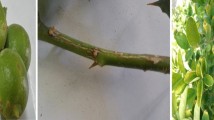Abstract
A specific molecular diagnostic test was developed to aid in the identification of Australian Armillaria species. The test involves polymerase chain reaction (PCR) amplification using the primer pair A1F and A2R followed by restriction cleavage by Taq 1. Sample populations of the four predominant Australian species, A. luteobubalina, A. hinnulea, A. fumosa and A. novae-zelandiae were collected in the form of basidiome tissue, diploid vegetative culture or infected root material. All samples were correctly identified as Armillaria using the test and subsequently identified to species level by comparing the Taq 1 restriction patterns. Variation was observed within A. luteobubalina Taq 1 restriction patterns, which suggested the presence of sexual recombination within the population. This procedure will assist in the diagnosis of Armillaria root rot and enable an accurate species identification to be made from infected root material or basidiome tissue.
Similar content being viewed by others
References
Banik M, Burdsall HH, Harold H (1998) Assessment of compatibility among Armillaria cepistipes, A. sinapina, and North American biological species X and XI, using culture morphology and molecular biology. Mycologia 90, 798–805.
Banik MT, Volk TJ, Burdsall HH (1996) Armillaria species of the Olympic Peninsula of Washington State, including confirmation of North American biological species XI. Mycologia 88, 492–496.
Harrington TC, Wingfield BD (1995) A PCR-based identification method for species of Armillaria. Mycologia 87, 280–288.
Kile GA, Watling R (1988) Identification and occurrence of Australian Armillaria spp. Transactions of the British Mycological Society 91, 305–316.
Knoche K, Kephart D (1999) Cloning blunt-end Pfu Polymerasegenerated PCR fragments into pGEMâ-T vector Systems. Promega Notes 71, 10.
Perez-Sierra A, Whitehead DS, Whitehead MP (1999) Investigation of a PCR-based method for the routine identification of British Armillaria species. Mycological Research 103, 1631–1636.
Sambrook J, Fritsch EF, Maniatis T (1987) ‘Molecular cloning: a laboratory manual (2nd edn).’ (Cold Spring Harbor Laboratory Press: Cold Spring Harbor, NY)
Schulze S, Bahnweg G, Moeller EM, Sandermann H (1997) Identification of the genus Armillaria by specific amplification of an rDNA-ITS fragment and evaluation of genetic variation within A. ostoyae by rDNA-RFLP and RAPD analysis. European Journal of Forest Pathology 27, 225–239.
Schulze S, Bahnweg G, Tesche M, Sandermann H (1995) Identification of European Armillaria species by restriction-fragment-lengthpolymorphisms of ribosomal DNA. European Journal of Forest Pathology 25, 214–223.
Volk TJ, Burdsall HH, Banik MT (1996) Armillaria nabsnona, a new species from western North America. Mycologia 88, 484–491.
White EE, Dubetz CP, Cruickshank MG, Morrison, DJ (1998) DNA diagnostic for Armillaria species in British Columbia: within and between species variation in the IGS-1 and IGS-2 regions. Mycologia 90, 125–131.
Author information
Authors and Affiliations
Corresponding author
Rights and permissions
About this article
Cite this article
Smith-White, J.L., Summerell, B.A., Gunn, L.V. et al. Molecular detection and differentiation of Australian Armillaria species. Australasian Plant Pathology 31, 75–79 (2002). https://doi.org/10.1071/AP01061
Received:
Accepted:
Issue Date:
DOI: https://doi.org/10.1071/AP01061




